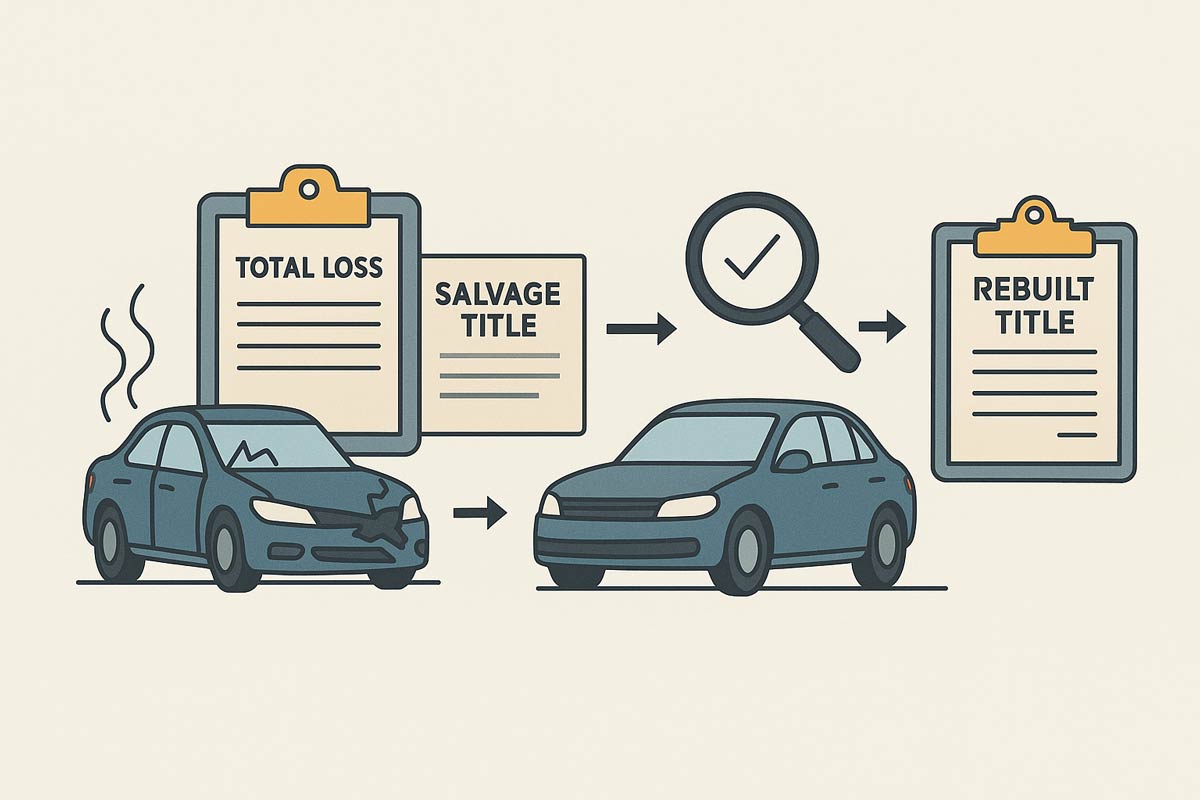 https://auction.ridesafely.com/images/2025/10/why-you-overbid-online-car-auctions-guide-banner.jpg
865
1440
RideSafely
/images/2025/01/ridesafely-logo.svg
RideSafely2025-10-24 13:00:092025-10-24 14:41:40Why You Overbid in Online Car Auctions — And How to Stop
https://auction.ridesafely.com/images/2025/10/why-you-overbid-online-car-auctions-guide-banner.jpg
865
1440
RideSafely
/images/2025/01/ridesafely-logo.svg
RideSafely2025-10-24 13:00:092025-10-24 14:41:40Why You Overbid in Online Car Auctions — And How to StopIf you’ve purchased or currently own a salvage vehicle, one of the biggest questions you’re likely asking is: How do I remove the salvage title? A salvage title can lower your car’s value, complicate insurance coverage, and even prevent registration. Fortunately, with the proper steps, you can convert that title from salvage to rebuilt and get your vehicle back on the road—or ready for resale. In this guide, we’ll walk you through everything you need to know to legally remove a salvage title and restore your vehicle’s full potential.
Before beginning the process, it’s smart to explore the diverse range of vehicles available at RideSafely. This helps buyers evaluate which vehicles are most suitable for rebuilding based on damage level, brand, and resale potential.
What Is a Salvage Title?
A salvage title is issued when an insurance company deems a vehicle a total loss due to severe damage from an accident, flood, repossession, theft recovery, or another major event. While this designation doesn’t always mean the vehicle is beyond repair, it does signal potential risks in terms of reliability and safety. Once classified as a total loss, the vehicle receives a salvage title and is often sold at an insurance auction with the intent to be rebuilt. Review our Damage Code Guide to better understand which types of repairs are most likely to be closely examined during the inspection process.
To make smart investment choices, many buyers enter the market through salvage car auctions—an opportunity to turn a profit while gaining experience.
Rebuilding a Salvage Vehicle: The Essential Requirements
To remove the salvage title and obtain a rebuilt title, we must:
- Repair the vehicle to a roadworthy condition.
- Comply with local DMV or state requirements.
- Pass a salvage vehicle inspection.
Tip: Keep detailed records of all repairs, including receipts from licensed mechanics and parts suppliers, and take clear photos throughout the process.
Required Documents to Begin the Rebuilt Title Process
Before applying to change the title status, the following are usually required:
- Original Salvage Title
- Photos of Vehicle Pre- and Post-Repair
- Receipts for Replacement Parts and Labor
- Completed Rebuilt Title Application Form
- Proof of Ownership and Identity
- VIN Verification (where applicable)
State-Required Salvage Inspections
Most states require a salvage inspection to ensure:
- The vehicle has been properly repaired.
- There are no stolen parts used.
- The VIN matches and is intact.
The inspection may be conducted by the DMV, a certified third-party inspector, or a licensed mechanic, depending on the state. Inspection fees typically range from $50 to $200, depending on the state.
State-by-State Breakdown: Salvage Title Removal Process
Here’s how different states handle the process:
| State | Inspection Required | Key Requirements |
|---|---|---|
| California | Yes | Brake & lamp inspection, CHP VIN verification |
| Texas | Yes | Rebuilt title application with VTR-61 form |
| Florida | Yes | Form HSMV 82040, rebuilt affidavit required |
| New York | Yes | Must pass NY Salvage Examination Program |
| Illinois | Yes | Photos of damage, minimum 4 repair documents |
| Georgia | Yes | Inspection by state-authorized rebuilder only |
| Pennsylvania | Yes | Enhanced safety inspection at certified station |
| Arizona | Yes | Level III inspection mandatory by ADOT |
| Nevada | Yes | VIN inspection plus review of all parts invoices |
Learn more about reconstruction procedures across various U.S. states in our FAQ: What is the Vehicle Reconstruction Process?
Can You Register and Insure a Rebuilt Title?
Yes, but with conditions:
- Registration: Allowed only after passing inspection and obtaining the rebuilt title.
- Insurance: Not all carriers offer full coverage. Liability coverage is common; comprehensive and collision may require extra steps or inspection from the insurer.
Find out how to get coverage for your salvage vehicle.
What to Know Before Buying a Vehicle with a Rebuilt Title
While removing a salvage title increases value, a rebuilt title still impacts:
- Resale Value: Typically 20%–40% lower than clean title vehicles.
- Financing Options: Limited lenders support rebuilt titles.
- Warranty Coverage: Often voided entirely.
To avoid costly mistakes during auction bidding, check out our proven tips on how to win at salvage car auctions—without losing your shirt.
Title Status Flow – From Salvage to Road-Ready
| Step | Description |
|---|---|
| 1 | Damaged Vehicle – Car sustains significant damage from accident, flood, fire, or theft. |
| 2 | Insurance Declares Total Loss – Vehicle is deemed uneconomical to repair. |
| 3 | Salvage Title Issued – Title status is officially marked as “salvage.” |
| 4 | Vehicle Repaired – The car is restored to drivable, safe condition. |
| 5 | Inspection Scheduled – Appointment made with DMV or authorized inspector. |
| 6 | Inspection Passed? – Vehicle is evaluated for compliance and safety. |
| 7 (If Passed) | Rebuilt Title Issued – DMV changes the title from salvage to rebuilt. |
| 7 (If Failed) | Additional Repairs Needed – Issues are identified and must be corrected before retesting. |
| 8 | Reinspection – Process loops back to vehicle repair and inspection until passed. |
Steps to Remove a Salvage Title — Summary Checklist
- Purchase the vehicle with a salvage title
- Repair the vehicle to meet road safety standards
- Gather all invoices, photos, and documentation
- Apply for salvage inspection in your state
- Pass inspection and complete DMV forms
- Receive your rebuilt title
- Register the vehicle for road use
- Insure your car under a rebuilt title policy
Bottom Line
Removing a salvage title is a multi-step process that typically includes gathering the necessary documentation, completing all required repairs, passing a state inspection, and submitting paperwork to the appropriate agency. Each state may have slightly different requirements, making it essential to follow your local DMV guidelines closely. At RideSafely, we strongly recommend partnering with a certified mechanic throughout the process. A professional can help ensure that all repairs meet safety standards and that no critical steps are overlooked. This protects your financial investment and ensures the vehicle is safe and reliable for the road ahead.
Salvage Title Removal FAQs
Can I drive a vehicle with a salvage title?
No. A vehicle with a salvage title cannot be legally driven on public roads until it has been repaired, passed inspection, and been issued a rebuilt title.
How do I convert a salvage title to a rebuilt title?
You must repair the vehicle, retain all documentation, pass a state-required salvage inspection, and apply for a rebuilt title through your local DMV.
How long does it take to remove a salvage title?
The process typically takes 2 to 8 weeks, depending on repair timelines, inspection availability, and DMV processing speed.
How much does it cost to get a rebuilt title?
Costs vary by state but generally include:
- Repair expenses: $500–$10,000+
- Inspection fees: $50–$200
- Title application and registration: $70–$400
Repair cost estimates are based on several factors, including the nature and extent of the damage, as well as the cost of parts and labor.
Can I insure a car with a rebuilt title?
Yes, but coverage options may be limited. Many insurers offer liability only, while others may require an inspection to provide comprehensive or collision coverage.
Will a vehicle history report still show the salvage title?
Yes. Services like Carfax or AutoCheck will permanently display the salvage history, even after a rebuilt title is issued.
Is buying a salvage car worth it?
It can be, especially if you’re experienced or working with a trusted mechanic. For best results, learn how to win at salvage car auctions without losing your shirt.






Leave a Reply
Want to join the discussion?Feel free to contribute!